

Genus: Anemone
Species: patens

Pasque flower is a pretty tundra plant. It is a member of the Ranunculaceae family, which is Latin for little frog. The name was given to the family because a group of plants in this family grow where frogs live.
The Pasque flower has several stems that rise 6-8 inches off the ground. On each stem is one flower with 5-8 petals. The range of color in the petals is from dark lavender to almost white. In the center of the flower are yellow stamens. Below the flower, around the stem is a leaf covered in silky hairs, as is the rest of the plant. The fruit of the plant is a plum that is achenial, which means that one seed is attached to the ovary wall, like a strawberry seed.
Pasque flower is found in many areas in the tundra. The plant only grows on southward facing slopes and is common throughout northwestern U.S. up to northern Alaska. The Pasque flower is also the state flower of South Dakota. It is popular in many home gardens. It likes well-drained, sandy, and gravelly soils as well as roadsides.
The Pasque flower, like all tundra plants, grows low to the ground to keep out of the cold climate. It is also covered in fine silky hairs, which help insulate it.
The Pasque flower is useful to treat eye diseases like cataracts, which is opacity on the lens of the eye, which can cause partial or complete blindness.
The Pasque flower is plentiful in the wild. It can be seen any where from northwest U.S. to northern Alaska.
by Ben P. 2001
Bibliography:
"Heartland Wild Flower",www.newsminer.com/heartland/hland6309/h30wild.htm (11/2/00)
"Kings American Dispensatory", www.ibiblio.org/herbmed/eclectic/kings/anemone-pate.html (11/3/00)
"Native Wildflowers of North Dakota", www.npwrc.usgs.gov/resource/literatr/wildflwr/species/anempate.htm (11/30/00)
"Pasque Flower", http://thinkquest.org/6274/stopandsmell/pasque.htm (11/3/00)